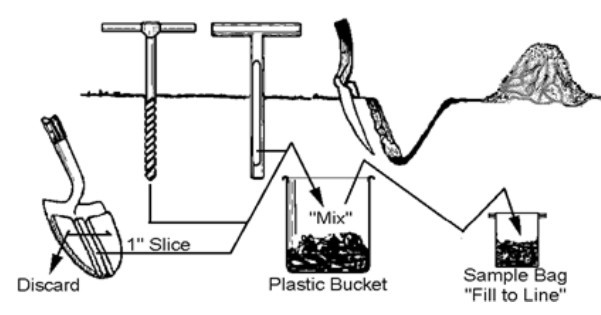Sampling depth:
Topsoil 0 - 300 mm.
Subsoil 300 - 600 mm.
The number of samples: A sample comprises a combination of at least 10 subsamples. A composite sample should not represent more than 3 ha. Samples from different orchards or lands should not be combined.
Distribution of sampling points: Take samples by walking diagonally from the corner through the orchard or land. In an established orchard, topsoil and subsoil samples should be taken at the same trees selected for leaf sampling. Soil samples must be taken under the canopy of trees in the middle between the stem and the drip area perimeter.
Method of sampling: Clear the soil surface of debris, leaves and fertiliser. A soil sample must not be taken too soon after fertilising because this will contaminate the soil sample and lead to an incorrect analysis. The top and subsoil samples are taken by removing a core of soil from the top 0 to 300 mm and then from 300 to 600 mm soil depth, respectively.
Packaging of samples: Subsamples from an orchard or land should be combined in the respective bucket (not a fertiliser bag) and mixed thoroughly. A sample of about 2 kg is taken from the composite sample and dispatched in a clean, strong bag.
Soil Sampling Procedures
Soil samples are required for making fertilizer recommendations. A soil or leaf analysis is no better than the procedures used to collect the sample. For samples to be representative of the area tested, follow these steps for sampling:

Soil samples may be conveniently taken when leaf samples are pulled. Soil sample bags are available from your laboratory agent. They should be used for submitting samples to the laboratory. Supply all the information asked for on the soil sample bags.
Use a spade, trowel, soil sampling tube, auger or another tool that can take a thin vertical slice of soil to a depth of 8 - 12 inches.
Take at least 12 or 15 cores or thin slices at random over the area to be sampled. In general, one composite sample consisting of 12 - 15 cores should be taken for each block of trees. If possible, the sample is under the predominant variety. (For example Stuart.) Place samples in a clean plastic bucket or other non-metal container and mix well. Fill the soil sample bag at least 3/4 full. Do not use a galvanized bucket if the soil is to be analyzed for zinc or other micronutrients.
Cores should be pulled within the drip line, not between rows. The area included in one sample should have been uniformly fertilized and limed in the past. When collecting the sample, avoid high or low spots, eroded areas, and areas along roads and fences. Sample problem areas within an orchard separately.
For field crops, soil samples should be taken before planting, so that the soil analyses can give an indication of the amount of fertilizer to be applied.
Depth will be determined by how deep the roots of the plants penetrate the soil. E.g. for cotton three soil samples are taken at three different depths since the cotton root can penetrate the soil from 60cm-100cm. Soil samples are taken from 15cm, 30cm and 60 cm.